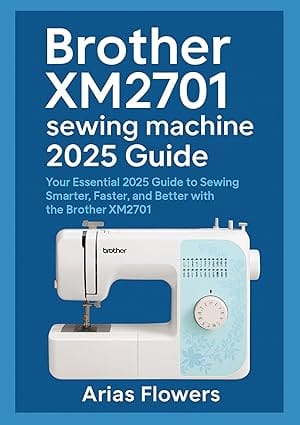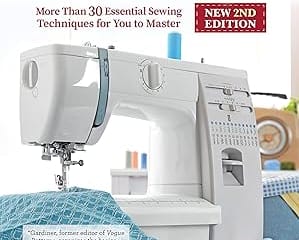Introduction:
Getting Started With Sewing. Sewing is not only a hobby, but an art and a life skill as well and to many, it is a profession.
You’ll learn: The way to select your first sewing machine.
How to use it correctly What features matter most Errors of newcomers to be avoided.
The art of sewing is no longer the preserve of grandmothers and has become a contemporary, artistic craft of people of any age
. This is why 2025 will be the right one to begin sewing: Affordable Machines: The contemporary entry-level machines have lower prices but are loaded with intelligent features. Online Tutorials: self-education is made accessible with the help of YouTube, Tik Tok, and sewing blogs. Eco-Smart Fashion:
Reusing and upcycling cloths helps in decreasing garbage. Side-earnings: There is demand of hand made clothes and alterations. Therapeutic Value: Sewing is relaxing, enhances creativity and increases concentration.
Sewing is an art that is cost effective, creates, and clears the way to business just in your house.
The blueprint of an understanding of the Sewing machine:
The beginner. You can familiarize yourself with the major parts of your machine before learning how to stitch.
🧵 Essential Parts of a Sewing Machine. Part Name Function Needle Pierces cloth and holds the upper thread. Presser Foot Pushes fabric as it is sewing.
Feed Dogs Push fabric on the needle. Bobbin & Bobbin Case Supply less thread to make stitches. Spoil Pin Grips the thread spool.
Thread Tension Dial Tightness of thread. Foot Pedal Regulates the speed of stitching.
Handwheel Raises and lowers the needle manually. Stitch Selector Gives you the option of selecting different stitch patterns.
Understanding how each of the parts works will make you use your machine more properly – and solve minor problems when they occur. The Guide to Selecting the best sewing machine as a beginner. Finding the right entry level machine can multiply the learning process by 10 times.
To future professionals, one can consider such machines as Brother CS7000X or Singer Heavy Duty 4423 – easy to use yet strong.
1. Make a Choice of Mechanical and Computerized.
Type Pros Cons Mechanical affordable, easy to operate, less serviceable Fewer stitches available. Computerized More features, automatic settings, digital accuracy More costly. Majority of the beginners begin using mechanical models as they are easy and low in cost.
2. Search in Beginner Friendly Features.
The following are what you should emphasize on: In-built stitches (620) -sufficient to get by. Free arm- suits sleeves and cuffs. Automatic needle threader- time saving. Drop-in bobbin – simple to install and thread visibility. Variable speed- very good at learning control. LED light lamp, workspace.
3. Set a Realistic Budget Beginners should pay between 120 and 300 dollars on good quality sewing machine.
Cheap unbranded mini machines are to be avoided except when you just need quick fixes. The Best beginner sewing machines in 2025.
The most convenient, economical, and dependable models are the ones listed below:
1. Brother GX37- Best All-round entry level machine.
Stitches: 37 built-in Best Uses: Amateurs and domestic sewers.
Advantages: Automatic threading, drop-in bobbin, long lasting motor.
Cons: No level detailing stitches. Price Range: $140–$180 Reasons to purchase it: It is among the simplest machines to operate and will last several years.
2. Singer Start 1304 -Top Budget Choice.
Price Range: $100–$130
Why: It is ideal when it comes to kids or beginners who have yet to get the basics.
3. Janome 2212- ideal mechanical option.
Cons: No automatic threading
4. Brother CS7000X -Top Computerized. Stitches:
70 Advantages: LCD screen, automatic threader, quilting table.
Cons: A little too sophisticated as a first-time user.
Price Range: $220–$300
Why Take it: It is a good one when you are a beginner and wish to get ahead.
5. Singer Heavy Duty 4423 -Most effective on Thick Fabrics. Stitches: 23
Insert the power cord and foot pedal.
Lift off the needle and presser foot with the handwheel.
Step 1: Winding the Bobbin Install the spool in the spool pin.
Place wrap thread on bobbin winder.
Step 2: Threading the Machine Use the threading diagram that comes with your machine (mostly numbered 1 7).
Move the thread up through the upper thread line. Go through the tension discs. Down through the take-up lever and up. Insert the needle at the back, forward.
Step 3: Pulling the Bobbin Thread.
Holding the top thread, catch the handwheel forward and draw both the threads out beneath the presser foot. Step 5: Selecting Stitch Type and Length.
Write the lines, corners and turns with scrap fabric.
Mistake Cause Fix Missing stitches Needle or threading that is incorrect Rebroken or changed needle Tangled thread Bobbin not set correctly Rethread bobbin correctly.
Uneven tension Bias in tension dial Adjust tension dial. Puckering of fabric Incorrect stitch length Longer stitch used on thick fabric.
Needle breaking Pulling cloth at sewing Let feed dogs push cloth Simple Sewing Projects:
Easy Sewing. Begin with simple undertakings that instruct in the rudiments of stitching and manipulation:
Fabric face mask Pillow cover Drawstring bag Apron Tote bag Simple skirt Table runner Cushion cover Both of them will teach you new tricks – straight seams and hemline and edge finishing.
Sewing Tips for Beginners Fabric type always should be used with the right needle.
Have a scrap piece of fabric to work on trying stitches. Begin gradually; it takes time to get fast.
Have your machine covered and clean.
Wipe up Lint and dust with each project. Moving components (read your manual).
Change needles frequently. Cover machine in order to exclude the formation of dust.
Maintenance on a yearly basis at a service center.
At What Point should you upgrade your machine?
Once you’ve mastered:
Threading Stitch selection Basic projects Troubleshooting
Remain fingers off the needle.
Turn off machine on threading or cleaning.
Use proper lighting.
Sewing machine beginner accessories you will require.
Seam ripper Tailor’s chalk Thread set Iron and ironing board These will facilitate your sewing experience and turn it into a more professional one.
Sophisticated Hints to Improve Quicker.
Get to know the variations of stitches: Zigzag, buttonhole, blind hem. Take courses online: It is wonderful on platforms such as Skill share or YouTube.
Play around with fabrics: Begin with cotton and play with knit or denim. Keep sewing record: Trace your projects, cloths and locations.
Attend sewing groups: You can be helped in forums and Facebook groups.
FAQS:
Q1. Which fabric is least complicated?
Cotton -it has not a way of stretching, nor of fraying, nor of slipping off the sewing machine.
Q2. What is the time of learning how to sew?
The majority of amateurs are able to produce basic garments in 1-2 months of practice.
Conclusion:
You Can Sew Now. One should also start with the proper beginner sewing machine. Sewing is no longer hard in 2025 – all people can acquire this ancient art with the assistance of the cheap, smart, and easy-to-use machines. You may decided to buy the Singer Start 1304, the brother GX37 or the Janome 2212, but remember:






0 Comments